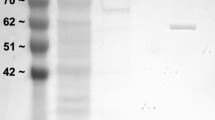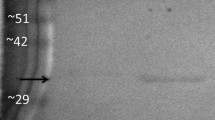Abstract
Both pyruvate kinase (PK) and phosphofructokinase (PFK) occur in two different forms, separable by isoelectric focusing (IEF), in skeletal muscle of the spadefoot toad Scaphiopus couchii. During estivation (aerobic dormancy) the proportions of the two forms changed compared with controls; in both cases the amount of enzyme in Peak I (pI = 5.3-5.4) decreased whereas activity in Peak II (isoelectric point = 6.2-6.4) increased. In vitro incubation of crude muscle extracts with 32P-ATP under conditions that promoted the activity of cAMP-dependent protein kinase led to strong radiolabeling associated with Peak I, but not Peak II, and reverse phase HPLC confirmed that 32P was associated with the subunits of both PK and PFK found in Peak I. Specific radiolabeling of Peak I PK and PFK by protein kinase A was further confirmed using immunoprecipitation. In total, this information allowed identification of the Peaks I and II enzymes as the phosphorylated and dephosphorylated forms, respectively, and the effect of estivation was to increase the proportion of dephosphorylated PK and PFK in muscle. Analysis of the kinetic properties of partially purified PK and PFK revealed significant kinetic differences between the two forms of each enzyme. For PK, the Peak II (low phosphate) enzyme showed a 1.6-fold higher Km for phosphoenolpyruvate and a 2.4-fold higher Ka for fructose-1,6-bisphosphate than did the Peak I (high phosphate) form. These kinetic properties suggest that Peak II PK is the less active form, and coupled with the shift to predominantly the Peak II form during estivation (87% Peak II vs. 13% Peak I), are consistent with a suppression of PK activity in estivating muscle, as part of the overall metabolic rate depression of the estivating state. A similar shift to predominantly the Peak II, low phosphate, form of PFK (75% Peak II, 25% Peak I) in muscle of estivating animals is also consistent with metabolic suppression since phosphorylation of vertebrate skeletal muscle PFK is typically stimulated during exercise to enhance enzyme binding to myofibrils in active muscle. Peak II PFK also showed reduced sensitivity to inhibition by Mg:ATP (I50 50% higher) compared with the Peak I form suggesting that the enzyme in estivating muscle is less tightly regulated by cellular adenylate status than in awake toads. The data indicate that reversible phosphorylation control over the activity states of enzymes of intermediary metabolism is an important mechanism for regulating transitions between dormant and active states in estivating species.
Similar content being viewed by others
References
Pinder AW, Storey KB, Ultsch GR: Estivation and hibernation. In: M.E. Feder, W.W. Burggren (eds). Environmental Physiology of the Amphibia. University of Chicago Press, Chicago, 1992, pp. 250–274.
Abe AS: Estivation in South American amphibians and reptiles. Brazilian J Med Biol Res 28: 1241–1247, 1995
Hochachka PW, Guppy M: Metabolic Arrest and the Control of Biological Time. Harvard University Press, Cambridge, 1987
McClanahan L: Adaptations of the spadefoot toad, Scaphiopus couchii, to desert environments. Comp Biochem Physiol 20: 73–79, 1967
Seymour RS: Energy metabolism of dormant spadefoot toads (Scaphiopus couchii). Copeia 3: 435–445, 1973
Jones RM: Metabolic consequences of accelerated urea synthesis during seasonal dormancy of spadefoot toads, Scaphiopus couchi and Scaphiopus multiplicatus. J Exp Zool 212: 255–267, 1980
Land SC, Bernier NJ: Estivation: mechanisms and control of metabolic suppression. In: P.W. Hochachka, T.P. Mommsen (eds). Biochemistry and Molecular Biology of Fishes. Elsevier Press, New York, 1995, Vol. 5, pp. 381–412
Brooks SPJ, Storey KB: Glycolytic controls in estivation and anoxia: A comparison of metabolic arrest in land and marine molluscs. Comp Biochem Physiol A118: 1103–1114, 1997
Storey KB, Storey JM: Facultative metabolic rate depression: molecular regulation and biochemical adaptation in anaerobiosis, hibernation and estivation. Quart Rev Biol 65: 145–174, 1990
Storey KB: Metabolic regulation in mammalian hibernation: Enzyme and protein adaptations. Comp Biochem Physiol A 118: 1115–1124, 1997
Brooks SPJ: A program for analyzing enzyme rate data obtained from a microplate reader. BioTechniques 17: 1154–1161, 1994
Helmerhorst E, Stokes GB: Microcentrifuge desalting: a rapid quantitative method for desalting small amounts of protein. Anal Biochem 104: 130–135, 1980
Brooks SPJ: A simple computer program with statistical tests for the analysis of enzyme kinetics. BioTechniques 13: 906–911, 1992
Grundy JE, Storey KB: Antioxidant defenses and lipid peroxidation damage in an estivating toad, Scaphiopus couchii. J Comp Physiol B 168: 132–142, 1998
Pilkis SJ, Claus TH, Kountz PD, El-Maghrabi MR: Enzymes of the fructose 6-phosphate – fructose 1,6-bisphosphate substrate cycle. In: P.D. Boyer, E.G. Krebs (eds). The Enzymes. Academic Press, New York, 1987, pp. 3–46.
Engstrom L, Ekman P, Humble E, Zetterqvist O: Pyruvate kinase. In: P.D. Boyer, E.G. Krebs (eds). The Enzymes. Academic Press, New York, 1987, pp. 47–75
Storey KB: Molecular mechanisms of metabolic arrest in molluscs. In: P.W. Hochachka, P.L. Lutz, T.J. Sick, M. Rosenthal, G. van den Thillart (eds). Surviving Hypoxia: Mechanisms of Control and Adaptation. CRC Press, Boca Raton, 1993, pp. 281–293
Foe LG, Kemp RG: Properties of phospho and dephospho forms of muscle phosphofructokinase. J Biol Chem 257: 6368–6372, 1982
Zhao A, Malencik DA, Anderson SR: Protein-induced inactivation and phosphorylation of rabbit muscle phosphofructokinase. Biochemistry 30: 2204–2216, 1991
Luther MA, Lee JC: The role of phosphorylation in the interaction of rabbit muscle phosphofructokinase with F-actin. J Biol Chem 261: 1753–1759, 1986
Brooks SPJ, Storey KB: Reevaluation of the “glycolytic complex” in muscle: A multitechnique approach using trout white muscle. Arch Biochem Biophys 267: 13–22, 1988
Brooks SPJ, Storey KB: Phosphofructokinase from a vertebrate facultative anaerobe: effects of temperature and anoxia on the kinetic properties of the purified enzyme from turtle white muscle. Biochim Biophys Acta 1037: 161–164, 1990
Su JY, Storey KB: Regulation of phosphofructokinase from muscle and liver of rainbow trout by protein phosphorylation. Biochem Mol Biol Intl 33: 1191–1200, 1994
Author information
Authors and Affiliations
Rights and permissions
About this article
Cite this article
Cowan, K.J., Storey, K.B. Reversible phosphorylation control of skeletal muscle pyruvate kinase and phosphofructokinase during estivation in the spadefoot toad, Scaphiopus couchii. Mol Cell Biochem 195, 173–181 (1999). https://doi.org/10.1023/A:1006932221288
Issue Date:
DOI: https://doi.org/10.1023/A:1006932221288




